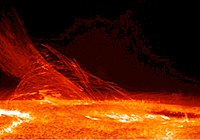
Photo from wikipedia
In this study, a RANS model of turbulent conjugate heat transfer has been developed, which is applicable across a range of different combination of fluid and solid thermal properties. This… Click to show full abstract
In this study, a RANS model of turbulent conjugate heat transfer has been developed, which is applicable across a range of different combination of fluid and solid thermal properties. This is achieved by focusing on the transport equations for the temperature variance and its dissipation rate across the solid walls which bound the flow region. In this investigation we make use of a wider range of DNS data reported by other researchers, to advance our understanding of the processes involved and to revise and extend the capabilities of the model of Craft et al [12] including a more physical fluid-solid interface condition on the dissipation of thermal fluctuations and a dependence of model coefficients on Prandtl number. The resulting model is shown to successfully reproduce the penetration of thermal fluctuations into solid regions, and their subsequent decay across the solid, for a wide range of fluid to solid thermal property ratios, and Prandtl numbers, thereby bringing a step change to RANS capabilities in turbulent conjugate heat transfer analysis.
Journal Title: Journal of Turbulence
Year Published: 2020
Link to full text (if available)
Share on Social Media: Sign Up to like & get
recommendations!